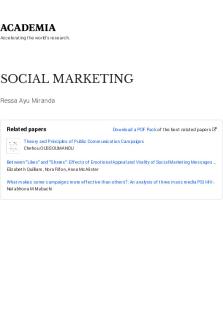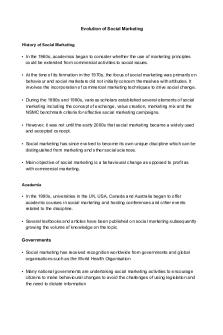Social Marketing - Lecture 1 PDF

| Title | Social Marketing - Lecture 1 |
|---|---|
| Course | Social Marketing |
| Institution | University of Strathclyde |
| Pages | 6 |
| File Size | 323.7 KB |
| File Type | |
| Total Downloads | 70 |
| Total Views | 148 |
Summary
Social Marketing lecture 1 - basis of course content and introduction to social marketing
...
Description
Lecture 1: Social Marketing- Overview of Social Marketing What is Social Marketing? “Social marketing is a process that uses marketing principles and techniques to change target audience behaviours to benefit society as well as the individual” – Nancy R. Lee, Mike Rothschild, Bill Smith (2011) Social marketing is a distinct marketing discipline being labelled from early 1970 It has been practiced throughout the human history. o Free slaves o Abolish child labour o Women’s right to vote o Recruit women into the workplace Various definitions exist, but in common it is about: o Influencing behaviours o Utilizing a systematic planning process that applies marketing principles and techniques o Focusing on priority target audience segments o Delivering a positive benefit for society Different Types of Behaviours Accept a new behaviour Reject a potentially desired behaviour Modify a current behaviour Abandon an old behaviour Influence the continuity of a desired behaviour Switch a behaviour Major Categories of Social Issues Improving Health (e.g., Tobacco use, heavy/binge drinking obesity, breastfeeding) Preventing Injuries (e.g., drinking and driving, seatbelts, domestic violence) Protecting the Environment (e.g., waste reduction, water conservation, wildlife habitat protection, home garden waste composting) Involving the Community (e.g., organ donation, blood donation, voting, animal adoption) Enhancing Financial Well Being (e.g., fraud, bankruptcy, establishing bank accounts) Social Marketing is Not Commercial marketing - selling goods and services for profit Non-profit marketing - promote services of the organisation and support fundraising Social media marketing – Facebook, Twitter, Instagram etc. Education – to inform and gain skills Cause Marketing – increase awareness and concern for social causes Social Marketing vs. Commercial Marketing
SIMILARITIES Customer orientation (appeal to target audience, meeting the needs of one's customers, solve their problems) Exchange theory is fundamental (perceive benefits exceed perceived costs) Marketing research is used throughout the planning process Market segmentation is essential Use of 4P intervention tools Conduct evaluations of the marketing DIFFERENCES Selling goods & services versus behaviours Financial gain versus societal gain Competition is other organizations vs. current or preferred behaviours (and organizations selling or promoting competing behaviours, e.g., tobacco industry) Different ways of segmentation But Why is it So Hard? We ask people to “pay” and we don’t always have something to give them in return, especially in the near term, and it might be associated with negative utilities: o Be uncomfortable (e.g., giving blood, pregnant women to wear a seatbelt) o Reduce pleasure (e.g., taking shorter showers) Spend more time (e.g., flatten cardboard boxes before recycling) o Give up an addictive behaviour (e.g., stop smoking) o Hear bad news (e.g., get an HIV test) o Give up leisure time (e.g., volunteering) o Change a comfortable lifestyle (e.g., reduce thermostat setting) Benefits of Using Social Marketing Provides a 360 view of the issue Develops culturally appropriate interventions Involves those affected by the issue Enables effective use of resources Offers coordinated multiple intervention tactics Can be used for downstream and upstream influence Social Marketers Roles Upstream Social Marketing Policy makers Corporations Media Law enforcement Celebrities School Districts Non-profit Organizations Midstream Social Marketing Family & Friends
Neighbours Colleagues Health Care Providers Pharmacists Teachers Community Leaders Checkout clerks at retail stores
Who Does Social Marketing? Government Agencies o Department of Health o Department for Environment Foo & Rural Affairs o WHO Non Profit Organisations and Foundations o Cancer Research UK o British Heart Foundation o Fairtrade Foundation For Profit Organisations o Insurance Companies o Pharmaceuticals o Nurseries o Appliance Manufacturers Professional Services o Advertising Agencies o Public Relations Firm o Marketing Research Firms o Consultants Unique Principles of Social Marketing Value Exchange – What’s in it for me? Benefits > Cost = Value Recognition of Competition The 4Ps of Marketing – Product, Price, Place, Promotion Sustainability Unique Value Proposition Social marketing is rooted in the belief that more than words and/or regulations are needed in order to succeed at influencing people’s behaviour. It builds on people’s perception of o Self-interest o Barriers to Behaviours o Competitive Forces that create alternative attractive choices It aims to… o Reduce Barriers o Increase benefits that to the audience and move people to action Social Marketing Planning Process Aiming to achieve social change Effective behaviour change interventions
10 step planning process Strategic Process Feedback is vital for ongoing development
A Strategic Process of Planning Why are you doing this? Where are you today? Where do you want to go? o Who do you want to influence? o What do you want them to do? How many? How are you going to get there? Strategies and Funding How will you keep on track and measure results? 10 Step Planning Process
Step 5: Barriers, Benefits, Competition Barriers are reasons your target audience cannot (easily) or does not want to adopt the behaviour. Benefits are reasons your target audience might be interested in adopting the behaviour or what might motivate them to do so. Competitors are behaviours your target audience prefers or organizations that support or promote “undesirable” behaviours.
Step 6: Positioning Statement The act of designing the organization’s actual and perceived offering “We want (TARGET AUDIENCE) to see (DESIRED BEHAVIOR) as (DESCRIPTIVE PHRASE) and as more beneficial than (COMPETITION).
Example 1: “We want people shopping for a puppy to visit the Humane Society’s website first to see if the pet they have in mind is just waiting for someone to adopt it, and that this is likely to be less expensive and more convenient option than going to the classified ads.” Example 2: We want pregnant women to see breastfeeding exclusively for the first six months as a way to bond with their child and contribute to their health and as more important than concerns about nursing in public.”
Step 7: Strategic Marketing Mix (The 4Ps)
Step 8: Evaluation Plan Why you will be evaluating? What will be measured? How and When?
Step 9: Budget Identify price tags for strategies and activities with cost-related implications. o Product-related costs o Price-related costs o Place-related costs o Promotion-related costs o Evaluation related costs
Step 10: Implementation Plan The implementation plan functions as a concise working document to share and track planned efforts. Most commonly, plans represent a minimum of 1-year activities, and ideally 2 or 3 years....
Similar Free PDFs

Social Marketing - Lecture 1
- 6 Pages

Marketing Social Media (1)
- 2 Pages

SOCIAL MARKETING
- 722 Pages

Marketing Lecture 1
- 3 Pages

Social media marketing mcq
- 4 Pages

social marketing proposal
- 17 Pages

Digital and social marketing
- 66 Pages

Social media marketing tutorial
- 15 Pages

In social media marketing
- 2 Pages

Evolution of Social Marketing
- 2 Pages

Social Media Marketing
- 10 Pages

Marketing mix - Lecture notes 1
- 7 Pages

Marketing. M1 - Lecture notes 1
- 24 Pages

Service Marketing - Lecture notes 1
- 204 Pages

Lecture 1: Intro to Marketing
- 27 Pages
Popular Institutions
- Tinajero National High School - Annex
- Politeknik Caltex Riau
- Yokohama City University
- SGT University
- University of Al-Qadisiyah
- Divine Word College of Vigan
- Techniek College Rotterdam
- Universidade de Santiago
- Universiti Teknologi MARA Cawangan Johor Kampus Pasir Gudang
- Poltekkes Kemenkes Yogyakarta
- Baguio City National High School
- Colegio san marcos
- preparatoria uno
- Centro de Bachillerato Tecnológico Industrial y de Servicios No. 107
- Dalian Maritime University
- Quang Trung Secondary School
- Colegio Tecnológico en Informática
- Corporación Regional de Educación Superior
- Grupo CEDVA
- Dar Al Uloom University
- Centro de Estudios Preuniversitarios de la Universidad Nacional de Ingeniería
- 上智大学
- Aakash International School, Nuna Majara
- San Felipe Neri Catholic School
- Kang Chiao International School - New Taipei City
- Misamis Occidental National High School
- Institución Educativa Escuela Normal Juan Ladrilleros
- Kolehiyo ng Pantukan
- Batanes State College
- Instituto Continental
- Sekolah Menengah Kejuruan Kesehatan Kaltara (Tarakan)
- Colegio de La Inmaculada Concepcion - Cebu
